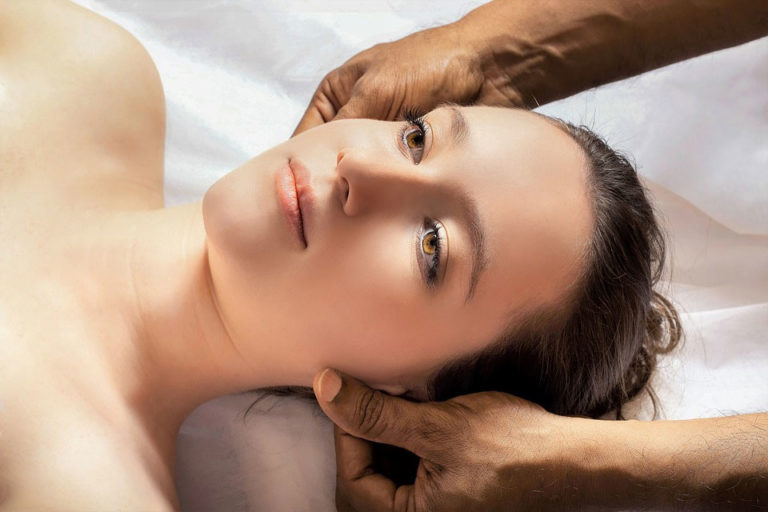It’s not news that massages offer more benefits to us than just a few heavenly minutes of relaxation (and some peace and quiet) – in reality they can serve as a natural solution to many of the illnesses, injuries, and everyday aches and pains we experience.
Of course, not all types of massages are suitable for every ache and pain – but the right massage can work wonders.
With that in mind, we are going to take a look at how massage therapy relates to and aids with one specific set of issues that many people experience: Temporomandibular disorders.
An Introduction to Temporomandibular Disorders
The term “Temporomandibular disorders” encompasses a variety of issues that affect one’s temporomandibular joint.
But What Is the Temporomandibular Joint?
To put it in the simplest terms, the temporomandibular joint (TMJ) is the piece that connects your jawbone to your skull (along with the various ligaments and muscles that are connected to it).
This piece, the TMJ is a small disc-like piece of cartilage that sits between the upper jawbone (which is along the base of your skull) and the lower jawbone.
Essentially, it is a hinge (yes, like on a door) that allows movement of the jaw. Unlike a door hinge, however, which only provides one form or direction of movement, the TMJ enables us to move our jaws in a few different ways.
Not only does the TMJ allow us to move our jaw in an up and down motion, we are also able to move our jaws in both a forward and backward sliding motion and a side-to-side sliding motion.
This range of motions combine to allow us to perform various functions such as speaking, chewing food, etc.
What Are Some Common TMJ Injuries?
Different injuries to the TMJ, known as the temporomandibular disorders (TMD), can arise due to a variety of reasons and can cause different symptoms for different individuals.
The most common causes of TMD are:
- Trauma to the jaw, joint, or surrounding muscles – such as whiplash or a forceful hit to the jaw/face – which can cause fractures or torn ligaments/muscles
- Grinding or clenching your teeth, which in turn causes too much pressure on the joint and can cause inflammation and soreness
- Arthritis in the joint
How Can I Tell If I Have A TMD?
Of course, you won’t know for sure unless you visit a doctor, but some common symptoms to watch for if you suspect you have injured your TMJ are:
- Pain, soreness, and general discomfort of the area (on one or both sides of your face)
- Difficulties opening and closing your mouth, especially when eating or yawning
- Clicking or popping noises when opening and closing your mouth
- Swelling (again, on one or both sides of your face)
- Toothaches, headaches, neck aches, or earaches
- And lastly, even dizziness or ringing in your ears (also known as Tinnitus)
Massage Therapy for TMD?
Many who suffer from TMD have found the typical doctor recommended exercises, medications, etc. to be of little to no help in reducing the pain and discomfort their TMJ is causing them. This leads to many cases of individuals dealing with these issues long term – living with the pain everyday.
Fear not.
If you have been diagnosed with a TMD, there may be a few ways to heal the joint – or at least relieve some of the pain and discomfort impeding on your daily life – using
massage therapy.
Intra-Oral VS. Extra-Oral Massages
When it comes to TMD, there are
two directions you can take with your massage therapy treatment: intra-oral or extra-oral.
Intra-oral massages consist of treatment of the muscles inside of the cheek. This means the massage is done inside of your mouth. Massaging these muscles from inside, rather than from outside of the mouth, can actually be up to 80% more effective.
Extra-oral massages include any massaging of the facial muscles around the mouth from the outside. These massages are less invasive – and in turn more comfortable – and still highly effective for treating a variety of TMD symptoms.
Below we will take a look at one type of extra-oral massage that is commonly used to help treat issues surrounding the temporomandibular joint.
Myofascial Release for TMD
Myofascial release is a technique used specifically to help relax muscles and soft tissues in order to regain function and treat chronic pain – both of which are symptoms highly common to TMD.
Your fascias are the connective tissues that surround your muscles – injury and inflammation of your fascias can cause pain and discomfort and restrict motion. These fascial restrictions are common for those who have issues with their TMJ.
So, What Is Myofascial Release?
This is a technique used by trained therapists that consists of light pressure being applied to the soft tissue area around the affected area to release fascial restrictions. This release is done by increasing blood flow in the area, relaxing the muscles, and elongating the fascial tissues.
What to Expect
Going for a Myofascial release session is very similar to going to any other type of massage therapy. Your session may last from 30 minutes up to an hour, and will begin with your therapist identifying the certain areas that will need to be worked on.
For TMD, the areas that your Myofascial therapist will typically work on include the muscles and soft tissues of your neck, shoulders, jaw, and various spots around your head (including the intra-oral massage technique we discussed earlier).
Of course, it’s also important to practice techniques outside of your scheduled appointments as well. Self-care techniques that your therapist can show to you will only quicken the healing process and keep the pain at ease.
What Are You Waiting For?
Many who have gone through various massage-therapy treatments for different issues surrounding their temporomandibular joint have seen significantly reduced pain and discomfort as well as increased flexibility and movement of the jaw.
If you have been diagnosed with any type of TMD, or are experiencing symptoms that sound like it could be TMD – speak with your medical professional about massage therapy treatments and whether or not they would be right for you.
References:
- https://www.massagetique.com/types/myofascial-release/
- http://www.rmtedu.com/blog/temporomandibular-disorders
- https://brontewellness.com/expect-tmjintra-oral-massage/
- http://intrains.co.uk/experience/shop
- https://paincareclinic.co.uk/pain/pain-conditions/tmj-and-jaw-pain/








